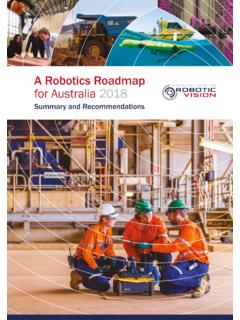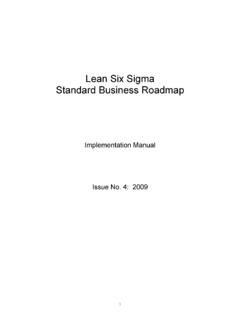Transcription of A Roadmap for US Robotics From Internet to Robotics
1 Georgia Institute of Technology University of Southern California Johns Hopkins University University of Pennsylvania University of California, Berkeley Rensselaer Polytechnic Institute University of Massachusetts, Amherst University of Utah Carnegie Mellon University Tech CollaborativeA Roadmap for US Robotics From Internet to RoboticsOrganized bySponsored byMay 21, 2009 Table of ContentsOverview Robotics as a Key Economic Enabler 1 Roadmap Results: Summary of Major Findings 2 Market Specific Conclusions 3 Further information 5 Chapter 1 Robotics and Automation Research Priorities for Manufacturing 7 Executive Summary 71. Introduction 82. Strategic Importance of Robotics in Manufacturing Economic Impetus Growth Areas A Vision for Manufacturing 113.
2 Research Roadmap The Process Robotics and Manufacturing Vignettes Critical Capabilities for Manufacturing 134. Research and Development: Promising Directions Learning and Adaptation Modeling, Analysis, Simulation, and Control Formal Methods Control and Planning Perception Novel Mechanisms and High-Performance Actuators Human-Robot Interaction Architecture and Representations 195. References 206. Contributors 21 Table of Contents iii A Roadmap for Robotics From Internet to RoboticsChapter 2 A Research Roadmap for Medical and Healthcare Robotics 23 Executive Summary 23 Motivation and Scope 23 Participants 24 Workshop Findings 241. Introduction Definition of the Field/Domain Societal Drivers 252. Strategic Findings Surgical and Interventional Robotics Robotic Replacement of Diminished/Lost Function Robot-Assisted Recovery and Rehabilitation Behavioral Therapy Personalized Care for Special-Needs Populations Wellness/Health Promotion 313.
3 Key Challenges and Capabilities Motivating Exemplar Scenarios Capabilities Roadmap Deployment Issues 424. Basic Research/Technologies Architecture and Representations Formal Methods Control and Planning Perception Robust, High-Fidelity Sensors Novel Mechanisms and High-Performance Actuators Learning and Adaptation Physical Human-Robot Interaction Socially Interactive Robots Modeling, Simulation, and Analysis 475. Contributors 49 Chapter 3 A Roadmap for Service Robotics 511. Introduction 512. Strategic Findings Principal Markets and Drivers Near-Term Opportunities and Factors Affecting Commercialization 54 Table of Contents Scientific and Technical Challenges 553. Key Challenges/Capabilities Motivating Scenarios Capabilities Roadmap 634.
4 Basic Research and Technologies Architecture and Representations Control and Planning Perception Robust, High-Fidelity Sensors Novel Mechanisms and High-Performance Actuators Learning and Adaptation Physical Human-Robot Interaction Socially Interactive Robots 705. Contributors 71 Chapter 4 Robotics : Emerging Technologies and Trends 731. Introduction 732. Strategic Findings Actuation Systems Energy and Power Systems Fabrication and Materials Technology Micro and Nano Technology Human-Robot Interfaces Communications and Networking Planning and Control Robustness and Reliability Perception and Machine Learning 783. Key Challenges / Capabilities Motivating/Exemplar Scenarios Capabilities Roadmap 804. Research/Technologies Actuation Systems Energy and Power Systems Fabrication and Materials Technology Planning and Control 855.
5 Contributors 86 OverviewRobotics as a Key Economic Enabler Over the past 50 years, robots have been primarily used to provide increased accuracy and throughput for particular, repetitive tasks, such as welding, painting, and machining, in hazardous, high volume manufacturing environments. Automating such dirty, dull, and dangerous functions has mostly involved implementing customized solutions with relatively specific, near term value. Although a sizeable industrial Robotics industry has developed as a result, the applications for such first generation Robotics solutions have proven to be relatively narrow and largely restricted to static, indoor environments, due to limitations in the enabling the past five years, however, tremendous advancements in Robotics technology have enabled a new generation of applications in fields as diverse as agile manufacturing, logistics, medicine, healthcare, and other commercial and consumer market segments.
6 Further, it is becoming increasingly evident that these early, next generation products are a harbinger of numerous, large scale, global, Robotics technology markets likely to develop in the coming decade. Owing to the inexorable aging of our population, the emergence of such a next generation, robotech industry will eventually affect the lives of every American and have enormous economic, social, and political impact on the future of our nation. Unfortunately, the United States lags behind other countries in recognizing the importance of Robotics technology. While the European Union, Japan, Korea, and the rest of the world have made significant R&D investments in Robotics technology, the investment, outside unmanned systems for defense purposes, remains practically non-existent.
7 Unless this situation can be addressed in the near future, the United States runs the risk of abdicating our ability to globally compete in these emerging markets and putting the nation at risk of having to rely on the rest of the world to provide a critical technology that our population will become increasingly dependent upon. Robotech clearly represents one of the few technologies capable in the near term of building new companies and creating new jobs and in the long run of addressing an issue of critical national articulate the need for the United States to establish a national robotech initiative, over 140 individuals from companies, laboratories, and universities from across the country joined forces to produce a definitive report that (1) identifies the future impact of Robotics technology on the economic, social, and security needs of the nation, (2) outlines the various scientific and technological challenges, and (3) documents a technological Roadmap to address those challenges.
8 This effort was sponsored by the Computing Community Consortium (CCC) and led by 12 world class researchers from the leading Robotics academic institutions in the United States. The project included three application oriented workshops that focused on efforts across the manufacturing, healthcare/medical, and services Robotics markets; plus one on blue-sky research that addressed a number of enabling technologies that must be the focus of sustained research and application development in order for the to remain a leader in Robotics technology and commercial development. Overview Robotics as a Key Economic Enabler 12 A Roadmap for Robotics From Internet to RoboticsWhat follows is a summary of the major findings across all of the workshops, the opportunities and challenges specific to each of the three targeted markets, and recommended actions that must be taken if the United States is to remain globally competitive in Robotics technology.
9 Detailed reports from each of the four workshops are also available. Roadmap Results: Summary of Major Findings Robotics technology holds the potential to transform the future of the country and is likely to become as ubiquitous over the next few decades as computing technology is today. The key driver effecting the long term future of Robotics technology is our aging population both in terms of its potential to address the gap created by an aging work force as well as the opportunity to meet the healthcare needs of this aging population. Led by Japan, Korea, and the European Union, the rest of the world has recognized the irrefutable need to advance Robotics technology and have made research investment commitments totaling over $1 billion; the investment in Robotics technology, outside unmanned systems for defense purposes, remains practically non-existing.
10 Robotics technology has sufficiently advanced, however, to enable an increasing number of human augmentation solutions and applications in a wide range of areas that are pragmatic, affordable, and provide real value. As such, Robotics technology offers a rare opportunity to invest in an area providing the very real potential to create new jobs, increase productivity, and increase worker safety in the short run, and to address the fundamental issues associated with economic growth in an era significant aging of the general population and securing services for such a population. Each workshop identified both near and long term applications of Robotics technology, established 5, 10, and 15 year goals for the critical capabilities required to enable such applications, and identified the underlying technologies needed to enable these critical capabilities.







